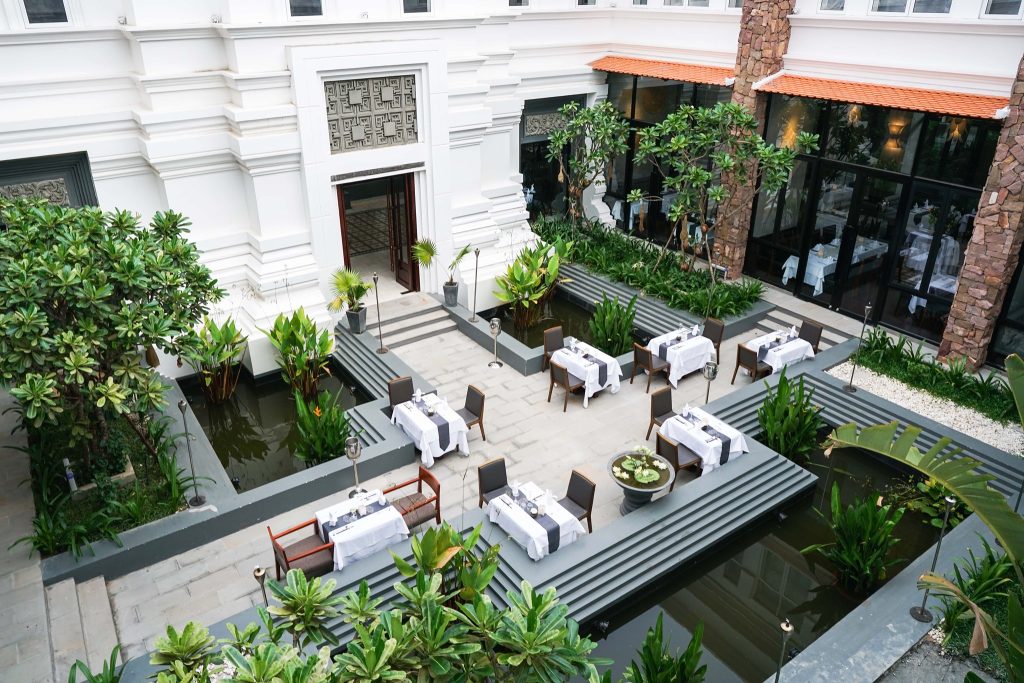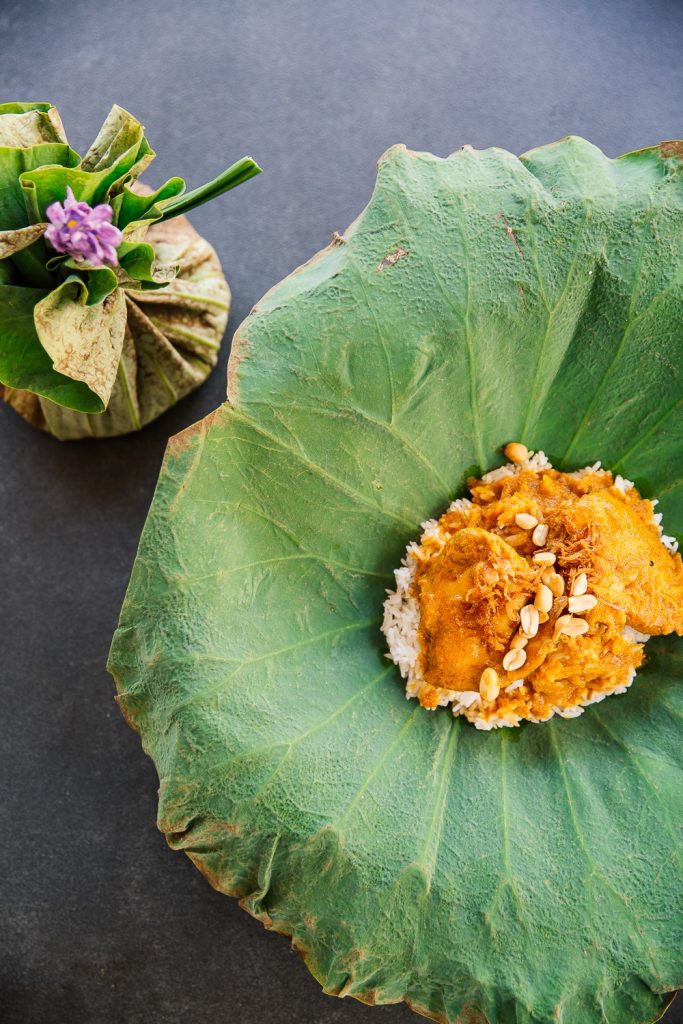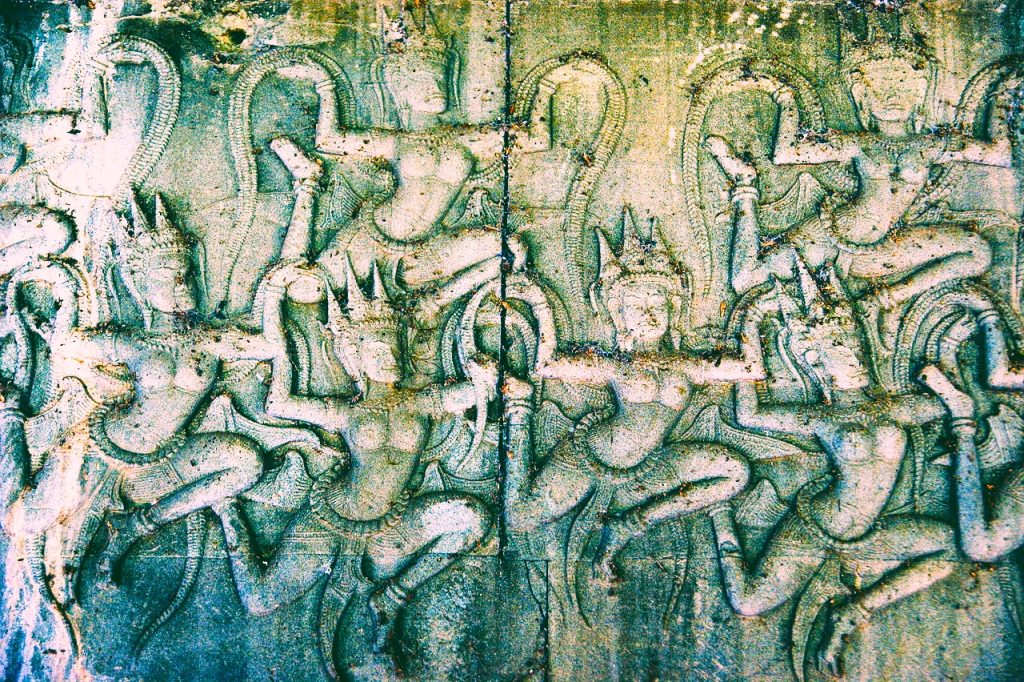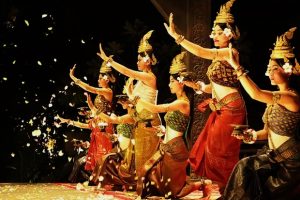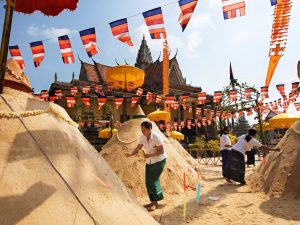In the early hours of April, 14th 2022, the angel Keriny Tevi will visit this earth to signal the start of the New Year 2022. Offerings of beans and sesame will be left for the Thursday angel, her favourite foods, and Khmer people all over the world will welcome her with candles, incense, chants, and prayers.
Keriny Tevy will be adorned in green silk, magnolia tucked behind her ear, and a necklace made of dazzling emeralds across her breast. The angel will descend to earth on her trusted elephant, guided by a flying tiger; she will be carrying an ankusha in her right hand and a crossbow in her left.
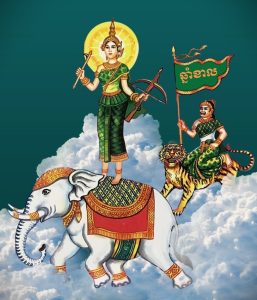

Three Riddles
Traditional Khmer Lore has it that a powerful family had built a large nesting area near a lake, this was for all of the birdlife to enjoy and make their homes. The family then gave birth to a son, who they named Dhammabal Koma. Dhammabal was an exceptionally intelligent young boy, finishing his education by the age of just seven. He also learned to communicate with the birds he grew up with all around him and was respected by all who met him; his reputation grew throughout the land. People began to make pilgrimages to his village, to hear the young man’s wisdom, listen to his teachings and hear him converse with the birds.
Eventually, the King of Heaven, Kabel Moha Prom heard of the young man and the growing adulation surrounding him, he became envious, and so, decided to challenge Dhammabal Koma with a test.
The king summoned young Koma and presented him with three riddles:
In the morning, where is happiness?
At noon, where is happiness?
In the evening, where is happiness?
The god-king gave Dhammabal seven days to answer, if he answered correctly Kabel Moha Prom offered to cut off his own head, confident that it would never be separated from his body. However, he made it clear that if Dhammabal failed to answer correctly, it would be his head that was to be removed from its shoulders with immediate effect.
After six days of agonizing over the riddles, the learned young Koma was still completely at a loss, he had no answers. The boy decided he would flee into the forest, rather than face the king. After a while, he grew tired and stopped to rest under the shade of a palm.
There, high up overhead, atop the tree Koma overheard a conversation; a pair of vultures were contemplating what they might eat for dinner that evening. He was startled upon hearing the scavengers happily agree that they would be dining on the flesh of young Dhammabal, as he would have no answer for the king’s riddles.
Then one of the vultures asked the other if he knew the answers to these three riddles, to which the bird replied:
“In the morning, happiness lies in people’s faces as they splash them with cool water and prepare to meet the new day.
At noon, happiness is reflected on people’s chests as they bathe to cool their bodies from the afternoon heat.
In the evening, happiness exudes from people’s feet as they wash them to rest from the toils of the day and get ready for bed.”
Dhammabal Koma realized that his life young life was now spared, he quickly jumped to his feet and began sprinting toward the palace.
Three Rules
Upon hearing the correct answers, Kabel Moha Prom would remain true to his promise; first, he called his seven daughters to him and warned them that if his head were ever to touch the earth, the earth would explode into a blaze of fire, if his head were ever thrown into the air, there would be no more rain, and finally should his head ever be allowed to touch the ocean, it would evaporate in an instant, and if any of these three should ever be realized, all living things would perish. He asked his seven daughters to take turns carrying his head on a platter, to ensure these fates could never occur.
The act committed, Kabel Moha Prom’s severed head was handed to Tungsa, his eldest daughter, who placed it on a golden platter and took it to Mount Someru. It is said that a trillion angels circled the mountain that day, before bringing Kobel Mohaprom’s head to Kuntheakmali, the temple of heaven.
Ever since that fateful day, each year at Songkran, one of the seven daughters takes her turn carrying their father’s head in its ceremonial procession around Mount Someru, before passing it on to the next angel and departing for their brief visit to earth.
The festivities in Cambodia will last for three official days, and in preparation, people clean their homes (every single corner, just in case the angel checks!) and decorate it with lights, plants, and offerings for both their ancestral altar and their spirit house.
Day One: Moha Sangkran
The first day of the new year celebration. It is the end of the year and the beginning of a new one. People dress up and light candles and burn incense sticks at shrines, where the members of each family pay homage to offer thanks for the Buddha’s teachings by bowing, kneeling, and prostrating themselves three times in front of his image. For good luck, people wash their faces with holy water in the morning, their chests at noon, and their feet in the evening before they go to bed.
Day Two: Veareak Vanabat
The second day of the new year celebration. People contribute charity to the less fortunate by helping the poor, servants, homeless, and low-income families. Families attend a dedication ceremony to their ancestors at monasteries.
Day Three: Veareak Laeung Sak
On the third day, Buddhists wash their Buddha statues and their elders with perfumed water. Bathing the Buddha images is a symbolic practice to wash bad actions away like water cleaning dirt from household items. It is also thought to be a kind deed that will bring longevity, good luck, happiness, and prosperity in life. By washing their grandparents and parents, the children can obtain from them best wishes and good pieces of advice to live life for the rest of the year.
According to the Cambodia Coordinating Council:
‘One can look back at popular Khmer songs from the 60s and 70s to provide insightful details into Khmer New Year traditions. A song by legendary Khmer singer Sothear Serey Ros called “Chnam Tmey Mok Dol Hauy” or “The New Year Has Arrived” described how a group of girls got ready for the New Year by curling their hair, getting new dresses, and doing makeup. The daughters implore their parents not to stop them because the New Year only comes around once a year. Even if parents do give a big fuss, they cannot stop the girls. Sothear described a three-day festival of singing and dancing. They play traditional games like Chhoung and Teang Prot (tug-of-war). While having fun, the girls should not forget to offer food to the monks for blessings in the next life. The song was sung with the beat of Roam Kbach–a slow traditional dance beat.’
Khmer New Year is a time for families to come together to shed the worries of years past and look forward to the possibilities of the fresh new year ahead. Games will be played, singing and dancing will take place all over the country. Temples will be busy as people go to make merit in the style of Anaknang and perform the ceremony known as ‘Vealokchetei’, at a sandhill specifically erected at temples for each New Year, and known as ‘Cholamony Chaetdei’.
Traditional New Year foods will be prepared and then passed around to family, friends and monks. It is a time of immense joy in the kingdom, a time to let go of one’s worries and forget for three days about hardships. Traditional dishes in the villages will include: lort cha, (short, fried egg noodles), river snails, and of course there will be lots of num ansom chek, (banana) and num ansom chrouk, (pork) festive dishes of sticky rice wrapped in banana leaves. These are tied in the shape of the linga, said to represent the Hindu god Shiva. Another traditional festive snack is num kom, (sticky rice cakes) which are small pyramid-shaped sticky rice snacks. Num Kon is said to be the shape of the yoni, representing Uma the wife of Shiva. These dishes are popular for offerings at altars and shrines for departed ancestors and given to monks at the temple.




At Malis restaurant in Phnom Penh, master chef Luu Meng and his team prepare a special menu for families to gather and share. Meng tells me that they spend many months discussing, planning, and preparing each year, as they try to make it unique and special for their customers. Selecting the finest ingredients and combining traditional recipes with modern, fine dining techniques; the Khmer New Year’s menu at Malis is always one of the dining highlights of the culinary year.
